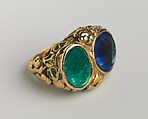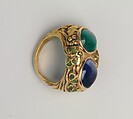Ring
Florence Koehler American
This ring was cast in 22-karat gold and features two large oval cabochon gems (a sapphire and an emerald) of irregular size in a nest-like setting of entwined leaves highlighted with pale green enamel and branches with berry clusters. The decoration continues along the sides of the ring towards the shank. This ring was originally made en suite with a brooch, necklace, and hair comb donated to the Metropolitan Museum in 1952 (52.43.1-3).
Embodying the ideals of the Aesthetic and Arts & Crafts movements, Florence Koehler worked in a variety of decorative media, including domestic interiors, china decorating, jewelry, and painting. In jewelry, as in pottery and painting, Koehler exhibited a scholar's sense of the past and a modernist's eye for the contemporary. Favoring pearls, gems, unpolished gold, and muted enamel, she derived inspiration from Renaissance designs she encountered during her extended stays in England, France, and Italy.
All of Koehler’s jewelry was custom-made for her close circle of friends that included well-known artists, writers, and socialites. This ring is a rare surviving example of her work. It was made for Emily Crane Chadbourne, daughter of the industrialist Richard Teller Crane. Koehler and Chadbourne spent many years as traveling companions and lived together in London at the time this ring and the corresponding brooch, necklace, and comb were made. When the rest of the suite was donated to The Met in 1952, the ring remained in the family, descending to Chadbourne’s niece, Florence Crane Belosselsky-Belozersky, and then to her daughter Tatiana Bezemat, from whom it was acquired by the Museum in 2008. The jewelry Koehler made for Chadbourne shows particular richness and intricacy and highlights the importance of female patronage during the Arts & Crafts movement.
Due to rights restrictions, this image cannot be enlarged, viewed at full screen, or downloaded.
This artwork is meant to be viewed from right to left. Scroll left to view more.




